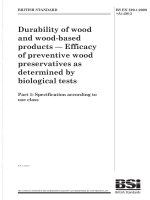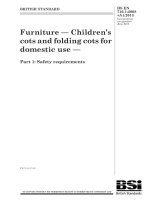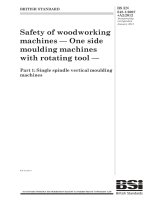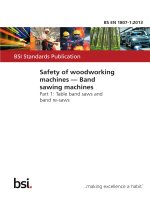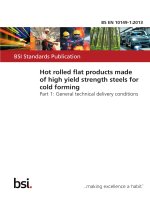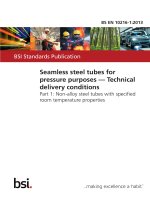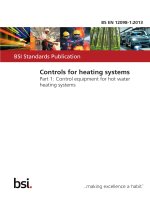Bsi bs en 61754 1 2013
Bạn đang xem bản rút gọn của tài liệu. Xem và tải ngay bản đầy đủ của tài liệu tại đây (1.15 MB, 18 trang )
BS EN 61754-1:2013
BSI Standards Publication
Fibre optic interconnecting
devices and passive
components — Fibre optic
connector interfaces
Part 1: General and guidance
BRITISH STANDARD
BS EN 61754-1:2013
National foreword
This British Standard is the UK implementation of EN 61754-1:2013. It
is identical to IEC 61754-1:2013. It supersedes BS EN 61754-1:1997
which is withdrawn.
The UK participation in its preparation was entrusted by Technical
Committee GEL/86, Fibre optics, to Subcommittee GEL/86/2, Fibre optic
interconnecting devices and passive components.
A list of organizations represented on this committee can be obtained on
request to its secretary.
This publication does not purport to include all the necessary provisions of
a contract. Users are responsible for its correct application.
© The British Standards Institution 2013.
Published by BSI Standards Limited 2013
ISBN 978 0 580 78243 5
ICS 33.180.20
Compliance with a British Standard cannot confer immunity from
legal obligations.
This British Standard was published under the authority of the
Standards Policy and Strategy Committee on 31 December 2013.
Amendments/corrigenda issued since publication
Date
Text affected
BS EN 61754-1:2013
EN 61754-1
EUROPEAN STANDARD
NORME EUROPÉENNE
EUROPÄISCHE NORM
November 2013
ICS 33.180.20
Supersedes EN 61754-1:1997
English version
Fibre optic interconnecting devices and passive components Fibre optic connector interfaces Part 1: General and guidance
(IEC 61754-1:2013)
Dispositifs d'interconnexion et composants
passifs à fibres optiques Interfaces de connecteurs à fibres
optiques Partie 1: Généralités et lignes directrices
(CEI 61754-1:2013)
Lichtwellenleiter Verbindungselemente und passive
Bauteile Steckgesichter von LichtwellenleiterSteckverbindern Teil 1: Allgemeines und Leitfaden
(IEC 61754-1:2013)
This European Standard was approved by CENELEC on 2013-09-24. CENELEC members are bound to comply
with the CEN/CENELEC Internal Regulations which stipulate the conditions for giving this European Standard
the status of a national standard without any alteration.
Up-to-date lists and bibliographical references concerning such national standards may be obtained on
application to the CEN-CENELEC Management Centre or to any CENELEC member.
This European Standard exists in three official versions (English, French, German). A version in any other
language made by translation under the responsibility of a CENELEC member into its own language and notified
to the CEN-CENELEC Management Centre has the same status as the official versions.
CENELEC members are the national electrotechnical committees of Austria, Belgium, Bulgaria, Croatia, Cyprus,
the Czech Republic, Denmark, Estonia, Finland, Former Yugoslav Republic of Macedonia, France, Germany,
Greece, Hungary, Iceland, Ireland, Italy, Latvia, Lithuania, Luxembourg, Malta, the Netherlands, Norway, Poland,
Portugal, Romania, Slovakia, Slovenia, Spain, Sweden, Switzerland, Turkey and the United Kingdom.
CENELEC
European Committee for Electrotechnical Standardization
Comité Européen de Normalisation Electrotechnique
Europäisches Komitee für Elektrotechnische Normung
CEN-CENELEC Management Centre: Avenue Marnix 17, B - 1000 Brussels
© 2013 CENELEC -
All rights of exploitation in any form and by any means reserved worldwide for CENELEC members.
Ref. No. EN 61754-1:2013 E
BS EN 61754-1:2013
EN 61754-1:2013
-2-
Foreword
The text of document 86B/3503/CDV, future edition 2 of IEC 61754-1, prepared by subcommittee 86B
“Fibre optic interconnecting devices and passive components” of IEC/TC 86 "Fibre optics" was
submitted to the IEC-CENELEC parallel vote and approved by CENELEC as EN 61754-1:2013.
The following dates are fixed:
•
latest date by which the document has
to be implemented at national level by
publication of an identical national
standard or by endorsement
(dop)
2014-06-24
•
latest date by which the national
standards conflicting with the
document have to be withdrawn
(dow)
2014-09-24
This document supersedes EN 61754-1:1997.
EN 61754-1:2013 includes the following significant technical changes with respect to EN 617541:1997:
a) general reconsideration of performance requirements;
b) addition of Figure 1.
Attention is drawn to the possibility that some of the elements of this document may be the subject of
patent rights. CENELEC [and/or CEN] shall not be held responsible for identifying any or all such
patent rights.
Endorsement notice
The text of the International Standard IEC 61754-1:2013 was approved by CENELEC as a European
Standard without any modification.
In the official version, for Bibliography, the following notes have to be added for the standards
indicated:
IEC 61753 Series
NOTE
Harmonised in EN 61753 series (not modified).
IEC 61931
NOTE
Harmonised as EN 61931 (not modified).
ISO 1101
NOTE
Harmonised as EN ISO 1101 (not modified).
ISO 2692
NOTE
Harmonised as EN ISO 2692 (not modified).
ISO 5458
NOTE
Harmonised as EN ISO 5458 (not modified).
ISO 5459
NOTE
Harmonised as EN ISO 5459 (not modified).
ISO 7083
NOTE
Harmonised as EN ISO 7083 (not modified).
BS EN 61754-1:2013
EN 61754-1:2013
-3-
Annex ZA
(normative)
Normative references to international publications
with their corresponding European publications
The following documents, in whole or in part, are normatively referenced in this document and are
indispensable for its application. For dated references, only the edition cited applies. For undated
references, the latest edition of the referenced document (including any amendments) applies.
NOTE When an international publication has been modified by common modifications, indicated by (mod), the relevant EN/HD
applies.
Publication
Year
Title
EN/HD
IEC 60050-731
+ Corr. July
1991
1992
International Electrotechnical Vocabulary
(IEV) Chapter 731: Optical fibre communication
-
IEC 60874-1
2011
Fibre optic interconnecting devices and
EN 60874-1
passive components - Connectors for optical
fibres and cables Part 1: Generic specification
IEC 61754
Series Fibre optic interconnecting devices and
passive components - Fibre optic connector
interfaces
EN 61754
Year
-
2012
Series
BS EN 61754-1:2013
–2–
61754-1 IEC:2013
CONTENTS
INTRODUCTION ..................................................................................................................... 5
1
Scope .............................................................................................................................. 6
2
Normative references ...................................................................................................... 6
3
Terms and definitions ...................................................................................................... 6
4
Dimensioning system ....................................................................................................... 9
5
Gauges ............................................................................................................................ 9
6
Tolerance grades ............................................................................................................. 9
Annex A (normative) Dimensioning connector interfaces ...................................................... 10
A.1
General ............................................................................................................ 10
A.2
Units ................................................................................................................ 10
A.3
Fundamental rules ........................................................................................... 10
Annex B (informative) Using interface standards .................................................................. 12
Bibliography .......................................................................................................................... 13
Figure 1 – Plug, adaptor, and receptacle for a connector examples ........................................ 9
BS EN 61754-1:2013
61754-1 IEC:2013
–5–
INTRODUCTION
An optical connector interface is a collection of physical features on a connector assembly
that defines a specified style. It consists of those minimum features that are functionally
critical (i.e. work together) during the mechanical mating and unmating sequences of the
connector with its counterpart component. The interface defines the size, relative location and
tolerance for each of the features. In addition, it defines the location for the optical datum
target.
This part of IEC 61754 contains those interfaces that have been standardized for international
use. It consists of individual sets of plug and adaptor interfaces. Each set contains at least
two counterpart interfaces that mate together. The standards therefore only ensure that the
two counterpart interfaces will mate together and that they will mate with a specified fit
tolerance between the mating features.
It is important to emphasize that the standard interfaces define physical dimensions only and
that no guarantee of performance is implied, nor should be assumed, for connectors that
comply with the standards. Manufacturers using the standards are responsible for positioning
the optical fibre or device port at the optical datum target location with the accuracy
necessary to meet their required performance.
An optical connector, by definition, mates with another optical component. Typically, the
mating component is another optical connector. In many cases, however, the mating
component is not another connector but rather an optical component such as a switch, a
branching device or an active device. The portion of the component that contains the mating
features to receive and position the connector is called an adaptor.
This standard makes a distinction between a connector interface and an adaptor interface. An
adaptor interface may not contain an optical datum target as in the case where two connector
plugs are engaged and are aligned by an alignment sleeve. However, the adaptor does
contain an optical datum target whenever it positions an optical fibre or optical fibre
waveguide, as in an active device or branching device.
BS EN 61754-1:2013
–6–
61754-1 IEC:2013
FIBRE OPTIC INTERCONNECTING
DEVICES AND PASSIVE COMPONENTS –
FIBRE OPTIC CONNECTOR INTERFACES –
Part 1: General and guidance
1
Scope
This part of IEC 61754 covers general information on the subject of fibre optic connector
interfaces. It includes references, definitions and rules for creating and interpreting the
standard drawings.
2
Normative references
The following documents, in whole or in part, are normatively referenced in this document and
are indispensable for its application. For dated references, only the edition cited applies. For
undated references, the latest edition of the referenced document (including any
amendments) applies.
IEC 60050-731:1991, International electrotechnical vocabulary – Chapter 731: Optical fibre
communication
IEC 60874-1:2011, Fibre optic interconnecting devices and passive components – Connectors
for optical fibres and cables – Part 1: Generic specification
IEC 61754 (all parts), Fibre optic interconnecting devices and passive components – Fibre
optic connector intefaces
3
Terms and definitions
For the purposes of this document, the following terms and definitions apply.
3.1
adaptor
component that permits mating between a connector and another optical component such as
a connector, an active device, a switch, a branching device, etc.
3.2
adaptor interface
features involved in the mating and unmating sequences of the adaptor with the mating
connector
Note 1 to entry:
This takes into account their size and relative locations.
Note 2 to entry:
It may also include an optical datum target.
3.3
alignment device
mechanical device that aligns at least one connector plug ferrule
Note 1 to entry: It is generally contained in an adaptor for the purpose of aligning one or two mating connector
plug ferrules coincident to a common optical datum target.
BS EN 61754-1:2013
61754-1 IEC:2013
–7–
3.4
basic dimension
numerical value used to describe the theoretically exact size, profile, orientation, or location
of a feature or datum target
Note 1 to entry: It is the basis from which permissible variations are established by tolerances on other
dimensions in notes, or in feature control frames.
3.5
connector interface
features involved in the mating and unmating sequence of the connector with a counterpart
component
Note 1 to entry:
This takes into account their size and relative locations.
Note 2 to entry:
It also includes the location of the optical datum target.
3.6
datum
theoretically exact point, axis or plane derived from geometric counterpart of a specified
datum feature
Note 1 to entry:
established.
A datum is the origin from which location or geometric characteristics of features of a part are
3.7
datum target
specified point, line, or area on a part used to establish a datum
3.8
dimension
numerical value expressed in appropriate units of measure and indicated on a drawing along
with lines, symbols, and notes to define the size or geometric characteristic, or both, of a part
or part feature
3.9
feature
general term applied to a physical portion of a part, such as a surface, hole, or slot
3.10
feature of size
one cylindrical or spherical surface, or set of two plane parallel surfaces, each of which is
associated with a size dimension
3.11
ferrule
mechanical fixture, generally a rigid tube, used to confine the stripped end of a fibre bundle or
an optical fibre
[SOURCE: IEC 60050-731:1991, definition 731-05-02]
3.12
geometrical tolerances
general term applied to the category of tolerances used to control form, profile, orientation
and runout
BS EN 61754-1:2013
–8–
61754-1 IEC:2013
3.13
least material condition
LMC
condition in which a feature of size contains the least amount of material within the stated
limits of size, e.g. maximum hole diameter or minimum shaft diameter are both least material
conditions
3.14
mating features
features of a connector that fit with the features of the counterpart connector during the
mating sequence
3.15
maximum material condition
MMC
condition in which a feature of size contains the maximum amount of material within the
stated limits of size, e.g. minimum hole diameter or maximum shaft diameter
3.16
optical datum target
theoretical datum point on a connector interface where the optical fibre core centre should be
positioned by the connector plug or by the adaptor receptacle
3.17
optical fibre connector
component normally attached to a cable or piece of apparatus for the purpose of providing
interconnection and disconnection of fibre optic cables
[SOURCE: IEC 60050-731:1991, definition 731-05-01]
3.18
optical fibre connector set
complete assembly of components required to provide demountable coupling between two or
more optical fibre cables
[SOURCE: IEC 60874-1:2011, definition 3.15]
3.19
optical port
location in an optical component through which optical energy enters and/or exits
3.20
plug connector
connector that is inserted into the receptacle interface of another optical component of the
same interface such as a receptacle connector, an active device, a switch, a branching device,
etc.
3.21
receptacle connector
female connector that receives the plug interface of another optical component of the same
interface such as a plug connector, an active device, a switch, a branching device, etc.
3.22
single limit dimension
dimension that is designated by MIN or MAX (minimum or maximum) instead of being labelled
by both
BS EN 61754-1:2013
61754-1 IEC:2013
–9–
Note 1 to entry: Single limit dimensions may be used where the intent is clear and the unspecified limit can be
zero or approach infinity without causing a condition that is detrimental to the design.
3.23
tolerance
total amount by which a specific dimension is permitted to vary
Note 1 to entry:
The tolerance is the difference between the maximum and minimum limits.
3.24
true position
theoretically exact location of a feature established by basic dimensions.
Figure 1 shows examples of plug, adaptor and receptacle for a connector.
Plug
Adaptor
Plug
Ferrule
Duplex plug
Duplex device receptacle
IEC 2136/13
Figure 1 – Plug, adaptor and receptacle for a connector examples
4
Dimensioning system
The interface dimensions listed in subsequent parts of IEC 61754 are presented and
interpreted using the tolerancing methods described in Annex A.
5
Gauges
This standard is not intended as a gauging standard. It is not intended that any gauges that
are included as a method for specifying sizes and locations of features shall be designed
exactly as illustrated, as long as the specified gauge dimensions are met.
6
Tolerance grades
Ferrules and alignment devices may be graded by tolerance. When grades are standardized,
each grade tolerance is identified in the standard by a grade number (i.e. 1, 2, etc.). The
grade number is annexed to the standard number.
BS EN 61754-1:2013
– 10 –
61754-1 IEC:2013
Annex A
(normative)
Dimensioning connector interfaces
A.1
General
Annex A covers the dimensioning, tolerancing and related practices to be used on the
connector interface drawings of IEC 61754. Uniform practices for stating and interpreting
these drawings are established herein.
This annex is not intended to replace existing standards on dimensioning and tolerancing.
Rather, it is intended to interpret and supplement, where necessary, the existing standards as
they apply to connector interfaces.
A.2
Units
The interface drawings shall use the International System of Units (SI) [1] 1.
A.3
Fundamental rules
Dimensioning and tolerancing shall clearly define the connector interface and shall conform to
the following:
a) Each dimension shall be referenced on the interface drawing using a capital letter. The
dimension values shall be tabulated in a supplementary table appearing with the drawing.
In general, the same reference letter should be used for the counterpart features on the
various drawings.
b) Each dimension shall have a tolerance, except for those dimensions specifically identified
as maximum or minimum only. The tolerance may be applied directly to the dimension, or
indirectly in the case of basic dimensions.
c) Dimensioning for size, form, and location of features shall be complete to the extent that
there is full understanding of the characteristics of each feature.
d) A gauge definition may replace a direct dimension when direct dimensioning of a feature
is impractical such as for resilient members, etc. When such dimensioning is used, a
supplementary drawing of the gauge shall appear with the drawing and a note shall clearly
state the use of the gauge.
e) Each mating feature for the interface shall be dimensioned. No more dimensions than
those necessary for complete definition of the mechanical interface shall be given. The
use of reference dimensions in the drawing shall be minimized.
f)
Dimensions shall be selected and arranged to suit the function and mating relationships
for the connectors and shall not be subject to more than one interpretation. The
dimensions provided are intended to define specific features and not intended to be added
or subtracted from other given dimensions in order to define undimensioned features.
g) The drawing shall define the interface without specifying manufacturing methods. Thus,
only the diameter of a hole is given without indicating whether it is to be drilled, reamed,
or made by any other operation.
h) Dimensions should be arranged to provide required information for optimum readability.
Dimensions should be shown in true profile views and refer to visible outlines.
___________
1
References in square brackets refer to the Bibliography.
BS EN 61754-1:2013
61754-1 IEC:2013
– 11 –
i)
A 90° angle is implied where centre lines and lines depicting features are shown on the
drawing at right angles and no angle is specified.
j)
A 90° basic angle applies where centre lines of features in a pattern or surfaces shown at
right angles on a drawing are located or defined by basic dimensions and no angle is
specified.
k) All dimensions are applicable at 20 °C unless otherwise specified. Compensation may be
made for measurements made at other temperatures.
l)
Where a tolerance of form is not specified, the limits of the dimensions for a feature
control the form as well as the size. The combined effect of size and form variations may
not exceed the envelope of perfect form at maximum material condition (MMC).
m) Where interrelated features of size (features shown with a common axis or centre plane)
have no geometric tolerance of location or runout specified, the limits of the dimensions of
a feature control the location tolerance as well as the size. When interrelated features are
at maximum material condition (MMC), they must be perfectly located to each other as
indicated by the drawing.
n) Where perpendicular features (features shown at a right angle) have no geometric
tolerance of orientation or runout specified, the limits of the dimensions for a feature
control the orientation tolerance as well as the size. When perpendicular features are at
maximum material condition (MMC), they have to fit perfectly orientated to each other as
indicated by the drawing.
o) As the size of a feature departs from maximum material condition (MMC), variations in
form, location and orientation are permissible.
BS EN 61754-1:2013
– 12 –
61754-1 IEC:2013
Annex B
(informative)
Using interface standards
The interface standards given in the IEC 61754 series fully define and dimension the features
that are essential for the mating and unmating of optical fibre connectors and other optical
components. They also serve to position the optical datum target, where defined, relative to
other reference datums.
The interface standards only ensure that connectors and adaptors that comply with the
standard will fit together. The standards may also contain tolerance grades for the ferrules
and alignment devices. Tolerance grades are used to provide different levels of alignment
precision.
The combined interface dimensions of the counterpart components in the interface may also
be used to design other components that will mate with other components of a connector
interface set. For example, an active device mount can be designed using the adaptor
interface dimensions. The use of these dimensions when combined with those of a standard
counterpart component provides the designer with assurance that the standardized
counterpart component will mate. The interface dimensions will also provide the mating force
and location of the plug's optical datum target.
Many other uses for the standards can be envisioned. For example, the use of two different
standard adaptor interfaces would allow the design of a between series adaptor (i.e. an SC to
an LSA adaptor), in that it would provide details of the necessary features to allow the mating
and unmating of the two different plugs on each side of the adaptor.
Standard interface dimensions do not, by themselves, assure optical performance. Optical
performance is described in the IEC 61753 series [2]. They do however assure connector
mating at a specified physical fit. Optical performance is defined by the manufacturing
specification. Products from the same or different specifications using the same standard
interface will always fit together. Obviously, an assurance of performance can be given for
product delivered to the same specification. In addition, it can be reasonably expected that
some level of performance will be attained by mating product from different specifications.
However, this common level of performance cannot be expected to be any better than that of
the lowest specified performance.
BS EN 61754-1:2013
61754-1 IEC:2013
– 13 –
Bibliography
[1] The International System of Units (SI)
[2] IEC 61753 (all parts), Fibre optic interconnecting devices and passive components
performance standard
Additional non-cited references
IEC 61931, Fibre optic – Terminology
ISO 1101, Geometrical product specifications (GPS) – Geometrical tolerancing – Tolerancing
of form, orientation, location and run-out
ISO 2692, Geometrical product specifications (GPS) – Geometrical tolerancing – Maximum
material requirement (MMR), least material requirement (LMR) and reciprocity requirement
(RPR)
ISO 5458, Geometrical Product Specifications (GPS) – Geometrical tolerancing – Positional
tolerancing
ISO 5459, Geometrical product specifications (GPS) – Geometrical tolerancing – Datums and
datum-systems
ISO 7083, Technical drawings – Symbols for geometrical tolerancing – Proportions and
dimensions
_____________
This page deliberately left blank
This page deliberately left blank
NO COPYING WITHOUT BSI PERMISSION EXCEPT AS PERMITTED BY COPYRIGHT LAW
British Standards Institution (BSI)
BSI is the national body responsible for preparing British Standards and other
standards-related publications, information and services.
BSI is incorporated by Royal Charter. British Standards and other standardization
products are published by BSI Standards Limited.
About us
Revisions
We bring together business, industry, government, consumers, innovators
and others to shape their combined experience and expertise into standards
-based solutions.
Our British Standards and other publications are updated by amendment or revision.
The knowledge embodied in our standards has been carefully assembled in
a dependable format and refined through our open consultation process.
Organizations of all sizes and across all sectors choose standards to help
them achieve their goals.
Information on standards
We can provide you with the knowledge that your organization needs
to succeed. Find out more about British Standards by visiting our website at
bsigroup.com/standards or contacting our Customer Services team or
Knowledge Centre.
Buying standards
You can buy and download PDF versions of BSI publications, including British
and adopted European and international standards, through our website at
bsigroup.com/shop, where hard copies can also be purchased.
If you need international and foreign standards from other Standards Development
Organizations, hard copies can be ordered from our Customer Services team.
Subscriptions
Our range of subscription services are designed to make using standards
easier for you. For further information on our subscription products go to
bsigroup.com/subscriptions.
With British Standards Online (BSOL) you’ll have instant access to over 55,000
British and adopted European and international standards from your desktop.
It’s available 24/7 and is refreshed daily so you’ll always be up to date.
You can keep in touch with standards developments and receive substantial
discounts on the purchase price of standards, both in single copy and subscription
format, by becoming a BSI Subscribing Member.
PLUS is an updating service exclusive to BSI Subscribing Members. You will
automatically receive the latest hard copy of your standards when they’re
revised or replaced.
To find out more about becoming a BSI Subscribing Member and the benefits
of membership, please visit bsigroup.com/shop.
With a Multi-User Network Licence (MUNL) you are able to host standards
publications on your intranet. Licences can cover as few or as many users as you
wish. With updates supplied as soon as they’re available, you can be sure your
documentation is current. For further information, email
BSI Group Headquarters
389 Chiswick High Road London W4 4AL UK
We continually improve the quality of our products and services to benefit your
business. If you find an inaccuracy or ambiguity within a British Standard or other
BSI publication please inform the Knowledge Centre.
Copyright
All the data, software and documentation set out in all British Standards and
other BSI publications are the property of and copyrighted by BSI, or some person
or entity that owns copyright in the information used (such as the international
standardization bodies) and has formally licensed such information to BSI for
commercial publication and use. Except as permitted under the Copyright, Designs
and Patents Act 1988 no extract may be reproduced, stored in a retrieval system
or transmitted in any form or by any means – electronic, photocopying, recording
or otherwise – without prior written permission from BSI. Details and advice can
be obtained from the Copyright & Licensing Department.
Useful Contacts:
Customer Services
Tel: +44 845 086 9001
Email (orders):
Email (enquiries):
Subscriptions
Tel: +44 845 086 9001
Email:
Knowledge Centre
Tel: +44 20 8996 7004
Email:
Copyright & Licensing
Tel: +44 20 8996 7070
Email:
